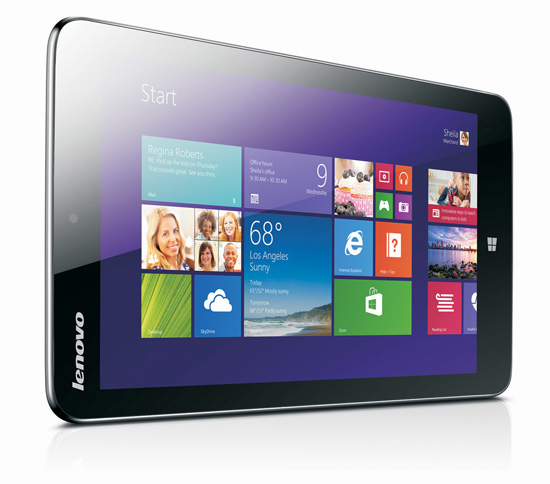The original Miix was a 10-inch tablet that included a wraparound keyboard cover so that you could use it like a laptop when you needed to do some typing. In contrast, the new Miix 2 8 is a straightforward 8-inch Windows tablet that you can fit into your jacket pocket. See the best tablets of 2014. The Miix 2 8 is also one of the more affordable Windows tablets we’ve seen so far, costing £250 for a model running the 32-bit version of Windows 8.1 with a 1.33 GHz Atom processor, 2GB of memory and 32GB of eMMC solid-state memory. In the same price camp is the Toshiba Encore at £250, also limited to 32-bit software by the creaky Intel processor. Other features include a 2 Mp front camera, 5 Mp rear camera, and a combined headphone/microphone socket. That’s the only configuration available here in the UK, although Lenovo is also planning to make 10-inch and 11-inch models that we hope to review soon. The Lenovo Miix 2 is a compact and neatly designed device, measuring just 8.4 mm thick, 215 mm high and 132 mm wide when held in upright portrait mode. A weight of 350 g means that it’s no trouble to hold the Miix 2 8 in one hand while you’re browsing the web, or to carry it around when you’re on the move. The super-svelte iPad Mini with Retina display is only slightly slimmer and lighter – at 331 g and 7.5 mm thick – so the Miix 2 8 can certainly hold its own in the high-tech fashion stakes. It feels quite sturdy, though, and we wouldn’t have any worries about carrying it around in a backpack or even a jacket pocket. The 1280 x 800 resolution of the Miix 2 8 can’t match the Retina display of the iPad mini, but its 8.0-inch IPS screen provides a bright, colourful image with very good viewing angles. It works a treat for web browsing and streaming video, and we got a full 8 hours and 15 minutes of battery life when running the BBC iPlayer so it can keep you entertained most of a day long. Our only complaint here is that the little internal speaker provides very modest volume levels. You’ll struggle to hear it in a crowded place, and you’ll need a set of headphones if you want to use the Miix 2 8 for listening to music. Fortunately, the Miix 2 8 provides good performance where it counts most. Its Intel Atom Z3740 is a quad-core processor with a basic clock speed of 1.33 GHz and a short ‘burst’ to 1.86 GHz. It achieved a score of 2500 points when running the PCMark 7 benchtest – considerably higher than the desultory 1477 points of the original Miix, and high enough to rival an entry-level laptop. The touch-screen controls responded quickly and smoothly during our tests, and the tablet wakes from sleep almost instantly when you need it. You probably won’t do much document editing or creation on such a small screen, but the Miix 2 8 could run Microsoft Office if you need to view work documents on the move. Unfortunately, the Miix 2 8 couldn’t run our Stalker test for 3D gaming performance, and gaming action will probably be limited to 2D tablet fare involving plants, zombies and irate avians. That’s no great hardship if your ambitions are office work and surfing. But the Miix 2 8 does have other more significant flaws. Its 2 GB of memory is sparse for running Windows, although it should still be adequate for basic tasks such as web browsing or simple wordprocessing. However, Windows itself takes up most of the 32 GB storage, leaving only about 8.5 GB left for your own use.
(Compare this to a 16 GB iPad mini, where 13 GB is left available to you – Tech Ed.) If you want to store a lot of music, photos or videos on the Miix 2 8 then you’ll need to use the microSD slot on the side of the device to expand limited storage. There’s no HDMI port for connecting an external display, and the single Micro-USB port is primarily designed for charging the device rather than connecting peripherals or additional storage. And, of course, there’s another major trade-off when choosing a tablet that runs Windows. If you specifically need Windows compatibility in order to view Microsoft Office documents on your tablet, then the Miix 2 8 is a reasonable choice. It’s affordable, highly portable, and provides good performance and usable battery life. However, the number of ‘modern’ Metro apps that are designed for Windows tablets still pales besides the half-million dedicated apps for the Apple iPad (1 million if you include iPhone apps too) and the thousands made for Android tablets.



